
Combtooth blennies are blenniiformids; percomorph marine fish of the family Blenniidae, part of the order Blenniiformes. They are the largest family of blennies with around 401 known species in 58 genera. Combtooth blennies are found in tropical and subtropical waters in the Atlantic, Pacific and Indian Oceans; some species are also found in brackish and even freshwater environments.

Entomacrodus is a genus of combtooth blennies.

Salarias is a genus of combtooth blennies found in the Indian and Pacific oceans.
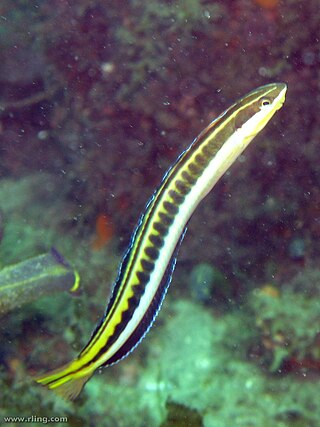
Plagiotremus is a genus of combtooth blennies found throughout the Pacific and Indian oceans.

Alticus is a genus of combtooth blennies found in the Pacific and Indian oceans. It is one of 57 genera in the family Blenniidae.
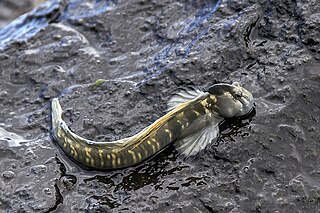
Alticus anjouanae is a species of combtooth blenny in the genus Alticus. Fourmanoir originally placed this species in the genus Andamia. It is a tropical blenny known from Comoros, Seychelles, and Réunion, in the western Indian Ocean. Males can reach a maximum total length of 7.6 centimetres (2.99 inches). Blennies in this species are oviparous and form distinct pairs when mating. They feed primarily off of benthic algae and weeds.

The Pacific leaping blenny, also known as the leaping rockskipper, is a species of combtooth blenny in the genus Alticus. The blennies are oviparous, and form distinct pairs when mating. Males can reach a maximum total length of 8 centimetres. These fish feed primarily on benthic algae, which they consume by scraping off rocky surfaces.

The East Indian lipsucker, Andamia heteroptera is a species of combtooth blenny found in the eastern Indian Ocean, around Christmas Island.
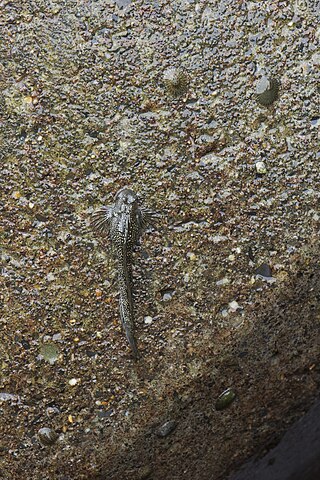
Andamia tetradactylus is a species of combtooth blenny found in the western Pacific Ocean, around the Ryukyu Islands and Indonesia. the IUCN classify this species as Data Deficient as this species, Andamia heteroptera and A reyii are confused and their exact distributions are uncertain.

Blenniella is a genus of combtooth blennies found in the Pacific and Indian Oceans.

Cirripectes is a large genus of combtooth blennies found throughout the Pacific and Indian oceans. Cirripectes biconvexus, an otolith based fossil species from the Burdigalian (Miocene) of southwestern India is probably the earliest record of this genus.

Hypleurochilus is a genus of combtooth blennies found throughout the Atlantic Ocean.

Meiacanthus is a genus of combtooth blennies found in the western Pacific and Indian oceans. Many species in this genus make their way into the aquarium trade and several are venomous. The genus name Meiacanthus is derived from the Greek meion meaning "less" and akantha meaning "thorn" and refers to most species having relatively few dorsal fin spines.

Omobranchus is a large genus of combtooth blennies found in the Pacific, Atlantic, and Indian oceans.
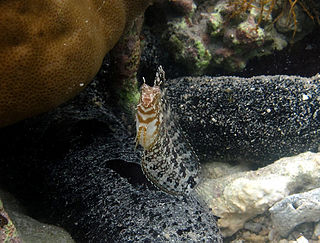
Petroscirtes is a genus of combtooth blennies found in the western Pacific, and Indian oceans. Some species of this genus have venom that interacts with opioid receptors. Adults usually inhabit coastal reefs and estuaries to depths of about 10 meters, but they can also be found up to 15 meters in depth in sandy and weedy areas among clumps of Sargassum or other seaweeds in coastal and lagoon reefs. They can be found in nests inside small-necked bottles and abandoned worm tubes or shells.
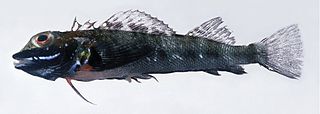
Helcogramma trigloides, the scarf triplefin, is a species of triplefin blenny in the genus Helcogramma. It was described by Pieter Bleeker in 1858 as Tripterygion trigloides. This is a widespread species in the western Pacific Ocean.

Salarinae is one of two subfamilies in the combtooth blenny family Blenniidae, it is the largest of the two subfamilies in the Blennidae with 43 genera. The species in this subfamily are mainly marine, with a few species which are found in freshwater or brackish water, and a few species are known to spend much time out of the water.
Andamia cyclocheilus is a species of combtooth blenny which is known from a single specimen from Atjatuning, western New Guinea. The IUCN rate it as Data Deficient because its taxonomy is unclear. It is associated with reefs.

Andamia expansa is a species of combtooth blenny which is known from a few specimens from the eastern Indian Ocean, with the type being collected in the Andaman Islands. The IUCN rate it as Data Deficient because its taxonomy is unclear. It forms pairs and lays adhesive eggs on the substrates.
Andamia pacifica is a species of combtooth blenny which is found in the Kerama Islands near Okinawa, Japan and is probably distributed along the Ryukyu Island chain. It is oviparous, laying adhesive eggs on the substrate, forming distinct pairs.


















